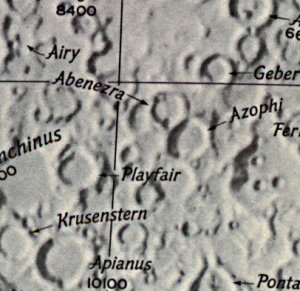

Observer: Tony Donnangelo Date/time of observation: 2003/07/06 01:55 U.T. Site location: Hummelstown RD 3, PA, USA (40.27°N., 76.75°W.) Site elevation: 362 feet (110 meters) Site classification: Suburban Instrument: Takahashi FS-102 Magnification: 234x (3.5mm Lanthanum SW) Moon's age: 6d 07:15, 38.5% illuminated Libration: N/S -6.22°; E/W -4.74° Object: Abenezra P (crater) Lunar ray coordinates: 10.0°E., 20.0°S. Rukl chart #: 56
There were a few clouds remaining after a rain storm moved through the area earlier. The rain did little to lower the temperature, which remained at 77° F. and hazy. Humidity was at 98%. My eyepieces kept fogging up, and a hair dryer was necessary to clear them. Transparency was poor, but the seeing was steady.
I started observing at 01:00 U.T., while civil twilight ended at 1:12 U.T. A lunar light ray was predicted to occur in Abenezra C at 1:19 U.T. The ray wasnít yet occurring. The floor of craters Abenezra C, Abenezra, and Azophi were totally shadowed. Their rims were illuminated, with the terminator approximately 2° to the west of C. The ray may occur at a later time. I continued monitoring C while observing other areas of the moon. I finished observing at 03:15 U.T. The moon was getting low to my horizon, nearly setting behind a tree in a very light polluted portion of the sky. No ray was still occurring in crater C. The floors of all three craters were still in shadow, with a ray still possibly occurring at a later time.
At 01:55 U.T., I observed the start of a lunar ray in crater Abenezra P, emanating from a notch in the eastern side of the crater wall. The ray began as a dim and very narrow shaft of light approximately 30 Km. long. The remainder of the craterís floor and interior walls was in total shadow with its rim brightly illuminated. The western part of the craterís wall abutted the diffuse area of the terminator. The exterior part of the eastern wall was illuminated.
Abenezra P appears to have a fairly flat floor with no apparent central peak. Several craterlets dot the floor. The northeastern part of the wall appears to be lower than the remaining rim of the crater. Crater T overlays the northwestern part of Pís floor and destroyed Pís wall in that section.
The ray was short lived, continuing to brighten and widen rapidly into a cone shape within 20 minutes. By 02:35 U.T., it broadened appreciably and now had a broad shadow of a high eastern-rim peak bisecting the ray along the floorís length. Approximately two-thirds of the crater floor was now illuminated. The ray was unrecognizable as such. The peakís shadow thinned and shortened quickly as the sun rose. By 03:15 U.T., the craterís interior was illuminated except for the eastern interior wall. The interior western walls of craters P and T were now especially bright.
Starting Date = 2003/7/6 at 18:48 U.T.
Site Longitude = +90.580
Site Latitude = +39.830
Site Elevation = +0.000
Reproducing Lighting For: 2003/7/6 at 01:55 U.T.
Desired Solar Altitude = +0.909(Rising), Azimuth = +88.523
Feature = Abenezra P
Feature Longitude: = +10.000
Feature Latitude: = -20.000
Average Co-longitude = 351.066
Moon's Altitude Restricted = Y Altitude = +10.000 degrees
In the Time column, D=Daylight, T=Twilight
---- Moon's ---- -- Earth's --
Topocentric Topocentric -------- Sun's --------
UT Date Time Alt° Semi-Diam'' Long° Lat° Colong° Lat° Azim°
2003/07/06 01:55T +39.220 968.25 -4.758 -4.915 351.457 +1.079 +88.523
Abenezra, +192,-358: This fine crater is 27 miles in diameter, and has loft walls rising 15,000 feet on both east and west. On the floor is a central mountain, whic is connected by a ridge to the south wall. Abenezra overlaps an older ring on the east, and this ring contains at least eight crater and two hills, which there are craters on its walls. The inner slopes of Abenezra are richly terraced. To the north of the ring is the crater B, and farther to the east a peculiar double depression, E. North of crater B is a partial ring, T. There are other fragmentary rings on the west and south. On the floor there is a crater at the foot of the north wall, and another on the south wall. - Wilkins and Moore, The Moon, Faber and Faber, 1955

